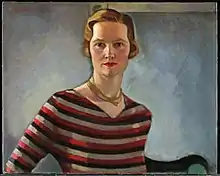Lilias Torrance Newton
Lilias Torrance Newton RCA (November 3, 1896 – January 10, 1980) was a Canadian painter[1][2][3][4][5] and a member of the Beaver Hall Group.
Lilias Torrance Newton | |
|---|---|
 Self-portrait, c. 1929 | |
| Born | Lilias Torrance November 3, 1896 Lachine, Canada |
| Died | January 10, 1980 (aged 83) Cowansville, Canada |
| Nationality | Canadian |
| Education | Art Association of Montreal |
| Known for | Painting |
| Spouse(s) | Frederick G. Newton
(m. 1921–1933) |
Early life and education
Lilias Torrance Newton was born in Lachine, Quebec, a suburb of Montreal, in 1896.[1][2][4] Her parents, Alice Mary Stewart and Forbes Torrance, were prominent Montreal figures; her father being a member of the Pen and Pencil Club of Montreal.[6] It is estimated that an old sketchbook of her father's is thought to be an early artistic inspiration.[7] She left school at 16 to attend classes given by William Brymner at the Art Association of Montreal,[1][3] where she won a scholarship in the Life class in her first year.[8] She later studied with Alfred Wolmark in London and Alexandre Jacovleff in Paris.[1][2][4]
Career
During the First World War, she worked for the Red Cross in England.[3] During the year of 1922 she won the Honorable Mention at the Paris Salon while studying with Alfred Wolmark.[9] Married in 1921 to Frederick G. Newton,[5] she had one child[1] and was divorced in 1933.[3][10] She was the only member of The Beaver Hall Group to marry.
Newton was elected an Associate of the Royal Canadian Academy in 1923, and became its third female member in 1937.[11] She became an Academician in 1939 and 1973.[1][3][4]
She was also a founding member of the Beaver Hall Group and the Canadian Group of Painters.[1][2][4] She taught at her alma mater, the Art Association of Montreal, and received an honorary LL.D. from the University of Toronto.[1] Newton is best known for her portraits, over 300 in her career, including her 1957 portraits of Queen Elizabeth II and Prince Philip. Newton was the first known Canadian commissioned to make a portrait of either subject.[1] Her portraits were known to be psychological in nature.[9] Her work is in the collections of the National Gallery of Canada, the Art Gallery of Alberta, the Glenbow Museum, the Art Gallery of Ontario, Hart House at the University of Toronto, the Montreal Museum of Fine Arts, the Musée national des beaux-arts du Québec,[12] the Canadian War Museum, and other public institutions in Canada.[4]
Personal life
She continued to paint until 1975, when she fell and broke her collarbone.[8] Lilias Torrance Newton died at the age of 83 in Cowansville, Quebec in 1980.[2]
References
- National Gallery of Canada biography
- Mayberry Fine Art biography Archived 2011-07-23 at the Wayback Machine
- Library and Archives Canada biography
- Canadian Women Artists History Initiative biography
- Farr, Dorothy; Luckyj, Natalie (1975). From Women's Eyes: Women Painters in Canada. Kingston: Agnes Etherington Art Centre. pp. 44–45.
- Millar, J. (1992). The Beaver Hall Group: Painting in Montreal, 1920-1940. Woman's Art Journal, 13(1), 3-9. doi:10.2307/1358252
- Walters, Evelyn (2005). The women of Beaver Hall : Canadian modernist painters. Toronto: Dundurn Press. pp. 81 .At sixteen, she left school to study full time with William Brymner at the Art Association of Montreal, where she won a scholarship in the Life class in her first year. ISBN 978-1-282-81085-3.
- Meadowcroft, Barbara; Walter, Galerie. "Lilias Torrance Newton Biography". Alan Klinkhoff Gallery. Archived from the original on 12 March 2017. Retrieved 11 March 2017.
- Millar, Joyce (1992). "The Beaver Hall Group: Painting in Montreal, 1920-1940". Woman's Art Journal. 13 (1): 3–9. doi:10.2307/1358252. JSTOR 1358252.
- Aylen, Marielle; Aylen-Gillies, Marielle (1999-01-01). Interfaces of the portrait: liminality and dialogism in Canadian womenś portraiture between the wars. Ann Arbor, Mich.: UMI.
- "The Canadian Encyclopedia". The Canadian Encyclopedia. Retrieved 11 March 2017.
- "Lillias Torrance Newton". www.collections.mnbaq.org. Retrieved 18 January 2020.